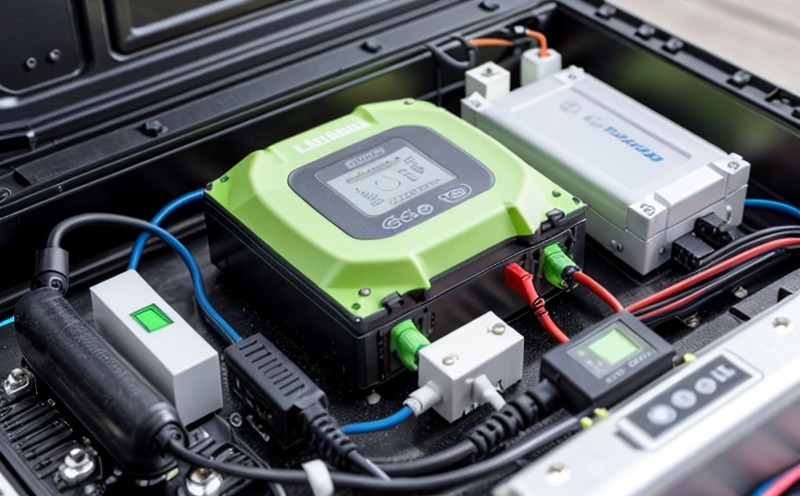SAE J2380 Lithium-Ion Battery Vibration and Environmental Testing
The SAE J2380 standard outlines a comprehensive suite of tests designed to evaluate the durability, reliability, and performance of lithium-ion batteries under simulated real-world conditions. This testing regimen is critical in ensuring that batteries meet stringent quality standards for automotive applications. The SAE J2380 protocol evaluates not only mechanical stress but also environmental factors such as temperature cycling, humidity, and vibration. This section will delve into the specifics of these tests, their significance, and how they contribute to the overall quality assurance process.
The primary test parameters include vibration testing at various frequencies and amplitudes that mimic road conditions, thermal shock cycles to simulate extreme environmental temperatures, and high/low humidity exposure. Specimens are subjected to these stressors individually and in combination to assess their robustness. The SAE J2380 protocol is particularly relevant for the automotive sector where the reliability of lithium-ion batteries can significantly impact vehicle performance.
When preparing specimens for testing under SAE J2380, it's essential to ensure they are representative of real-world conditions. This involves selecting appropriate cell types and ensuring that all components are securely mounted in test fixtures capable of withstanding the prescribed stresses. The testing apparatus used must comply with the latest standards, including those from ISO and ASTM.
The results of SAE J2380 compliance tests provide critical data on a battery's ability to withstand environmental and mechanical stresses. This information is invaluable for quality managers in ensuring that products meet industry benchmarks. Compliance officers can leverage these test outcomes to demonstrate adherence to regulatory standards, while R&D engineers use the insights gained from testing to refine product designs.
The SAE J2380 protocol is not just about meeting regulations; it's about enhancing product reliability and safety. By subjecting batteries to rigorous testing conditions, manufacturers can identify potential weaknesses early in the development process, enabling them to implement corrective measures before products reach market.
- Competitive Advantage: Compliance with SAE J2380 demonstrates a commitment to quality and reliability that is essential for maintaining a competitive edge. It ensures that products meet or exceed industry standards, which can translate into higher customer satisfaction and loyalty.
- Innovation Enabler: The protocol provides a robust framework for evaluating new technologies and materials, allowing manufacturers to innovate without compromising on safety and performance.
- Risk Mitigation: By identifying potential issues early in the development process, SAE J2380 helps mitigate risks associated with product failures. This reduces the likelihood of costly recalls and enhances brand reputation.
- Regulatory Compliance: The protocol ensures that products are up-to-date with international standards, facilitating smoother compliance processes and reducing regulatory barriers to market entry.
In conclusion, SAE J2380 Lithium-Ion Battery Vibration and Environmental Testing is a cornerstone of quality assurance in the automotive sector. It provides critical insights into battery performance under challenging conditions, enabling manufacturers to build more reliable and safer products. This comprehensive testing regimen not only ensures compliance with industry standards but also drives innovation and risk mitigation.
Benefits
The benefits of SAE J2380 Lithium-Ion Battery Vibration and Environmental Testing extend beyond mere compliance; they encompass a range of strategic advantages that contribute to long-term business success. By undergoing this rigorous testing process, manufacturers can gain several key competitive advantages.
Firstly, SAE J2380 ensures that products meet or exceed international standards, which is crucial for market entry in diverse regions. This compliance not only opens doors to new markets but also enhances brand credibility and customer trust. Secondly, the testing process reveals potential weaknesses early in development, allowing manufacturers to implement corrective measures before production begins.
Moreover, SAE J2380 promotes innovation by providing a structured framework for evaluating new technologies and materials. This enables manufacturers to stay ahead of industry trends while ensuring product reliability and safety. Lastly, the protocol helps mitigate risks associated with product failures, reducing the likelihood of costly recalls and enhancing brand reputation.
In summary, SAE J2380 Lithium-Ion Battery Vibration and Environmental Testing is a vital tool for manufacturers seeking to build reliable, safe, and innovative products that meet high-quality standards. It not only ensures compliance with industry benchmarks but also drives strategic business goals.
Why Choose This Test
When it comes to ensuring the reliability and safety of lithium-ion batteries in automotive applications, SAE J2380 Lithium-Ion Battery Vibration and Environmental Testing stands out as a critical service. Here's why:
Rigorous Validation: The protocol provides a comprehensive suite of tests that simulate real-world conditions, ensuring that products are robust enough to withstand mechanical stress and environmental challenges.
Regulatory Compliance: By adhering to SAE J2380 standards, manufacturers can ensure that their products meet regulatory requirements, facilitating smoother compliance processes and reducing the risk of non-compliance penalties.
Innovation Support: The testing regimen offers a structured framework for evaluating new technologies and materials, enabling manufacturers to innovate without compromising on safety and performance.
Risk Mitigation: Early identification of potential issues through rigorous testing helps mitigate risks associated with product failures. This reduces the likelihood of costly recalls and enhances brand reputation.
Enhanced Product Reliability: SAE J2380 testing ensures that products are reliable and safe, building customer trust and satisfaction. Reliable products lead to higher customer loyalty and repeat business.
Comprehensive Insights: The protocol provides critical insights into battery performance under challenging conditions, enabling manufacturers to make informed decisions about product design and development.
In summary, choosing SAE J2380 Lithium-Ion Battery Vibration and Environmental Testing ensures that products meet high-quality standards while driving strategic business goals. It is a crucial service for manufacturers seeking to build reliable, safe, and innovative products in the automotive sector.





